Webinar Strategies for a Post-Pandemic World
We have arrived at the second half of a second difficult year. Even though we’re still in the middle of a Pandemic, things are slightly different this time around. We are settling into new ways of getting things done using an enhanced understanding of the situation, and conducting highly effective webinars and other virtual experiences for the Post-Pandemic world. We are better prepared, have a lot more information and resources – and we need to deliver high-impact virtual experiences.
Adopt new tactics or reinvent webinars?
Ken Molay, in a recent webinar by the American Marketing Association, spoke about strategies and tactics to deliver high-engagement webinars in this Post-Pandemic world.
Ken is the founder and president of Webinar Success, an agency that supports companies that use webinars and web conferencing to communicate with employees, customers, prospects, and partners. He is one of the foremost experts in webinar best practices, a superb combination of knowledge, humor, and extensive experience.
Ken does not believe in reinventing the wheel when it comes to virtual events like webinars. Best practices remain best practices since the basic idea or objective remains the same. However, he emphasizes the greater importance of acting on what we know about our audiences and their needs. We need to focus on setting and meeting the expectations of our audience, instead of a complete makeover of how webinars are conducted.
So how does anyone stand out in this new digital-first world overcrowded with webinars, podcasts, videos, and infographics? For a start, we can take a closer look at some important points that Ken talks about in his webinars:
1) What do audiences want from marketing webinars?
2) What do typical engagement tips get wrong?
3) What are some ways to improve pre and post-webinar communication?
4) How does video help and hurt your webinar?
5) Why are shrinking attention spans a myth?
1) What do audiences want from marketing webinars?
Specificity:
While looking into what audiences want from their virtual experiences, it is important to understand the things that they certainly DO NOT want. Your audience does not want to be exaggerated/ lied to about what they will get out of a particular webinar. It is important to not overpromise and underdeliver. Using clickbait might get webinar registrations and attendance in the short term, but an increasingly tech-savvy audience is likely to start ignoring those who don’t deliver what they want. And the best way to figure out what anyone wants, is to just ask.
When they sign up for a particular webinar, they would generally appreciate it if the presenters focused on what is implied or promised. For example, a webinar sponsored by the American Marketing Association would have to be built around the marketing discipline.
And this needs to be clearly stated in the promotional communication. Even though this will reduce the number of registrations or attendees, the quality of webinar registrants in attendance will improve significantly. The return on investment would be much higher in the long run if you focus on the right things – helping the right people to find your webinars. And when the right people find you, they are more likely to keep coming back.
A stake in the webinar:
Asking prospects what they expect from the webinar, either at the registration or the follow-up stage, can help them feel more invested in the webinar and make them that much more likely to attend.
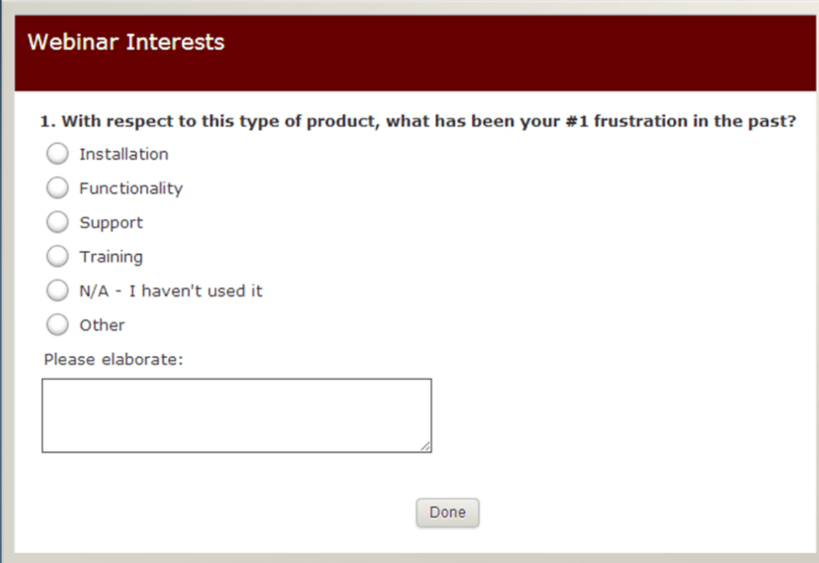
A poll like the one above not only helps pull the right audience in, but also helps your sales team to have enough knowledge about the audience’s needs for whenever they follow up with them.
Incentives:
Ken believes that incentives are a great way to reach the right people, especially topic-related incentives, like product discounts, free consulting, or access to academic papers on the same. While incentivizing is a good idea, you can also go wrong with them – irrelevant incentives like vouchers from e-commerce sites might end up attracting the wrong kind of crowd – one that does not have a genuine interest in the subject.
Relevant incentives not only help to give great value to those interested, but could also act as a deterrent for the wrong crowd.

There is usually no PERFECT way to incentivize people though, one needs to experiment with different tactics till you find one that could work better than others.
What do typical engagement tips get wrong?
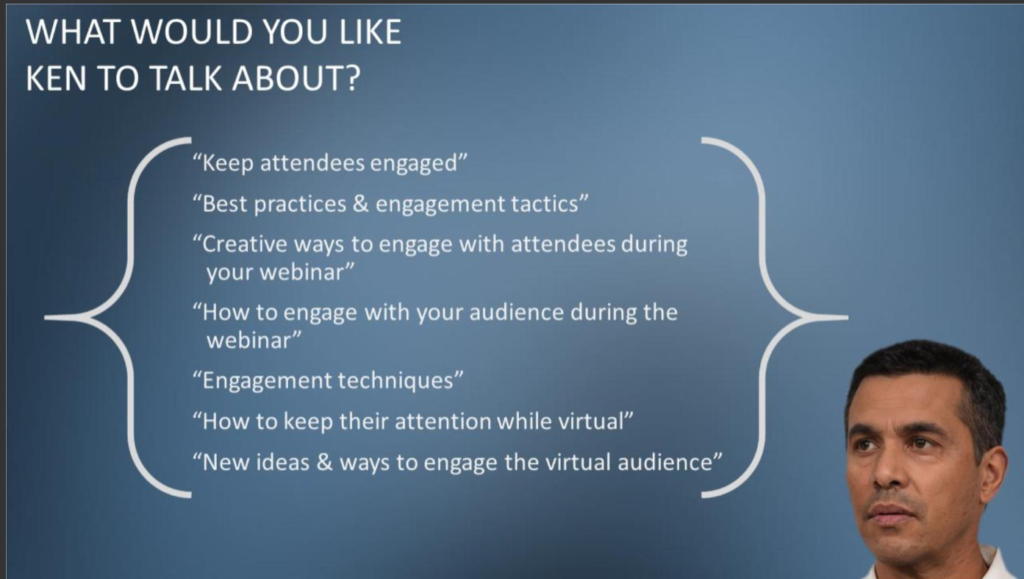
Interacting and calling it engagement:
The best kind of engagement does not engage for the sake of it, but is also responsive. It is about asking a question, receiving an answer, and responding to that answer. Engagement without a response or reaction is simply interaction. In his sessions, Ken tries to ensure that interaction helps take the conversation forward.
So the single biggest thing that engagement gets wrong is that it just isn’t engagement – it is often only interaction without engagement.
And the solution is to try and ensure that every time you engage the audience, there is a tangible outcome, even a small one.
Include the entire audience:

- Inclusive polls:
The poll given above is not an inclusive one – it misses out on including relevant options. A lot of the people you miss out on may have more say in decision making than you might realize, they might be on relevant committees or be promoted to managerial positions in the near future. This leaves a huge gap if we’re focusing only on the few we think are relevant.
What we need is Engagement by Inclusion:
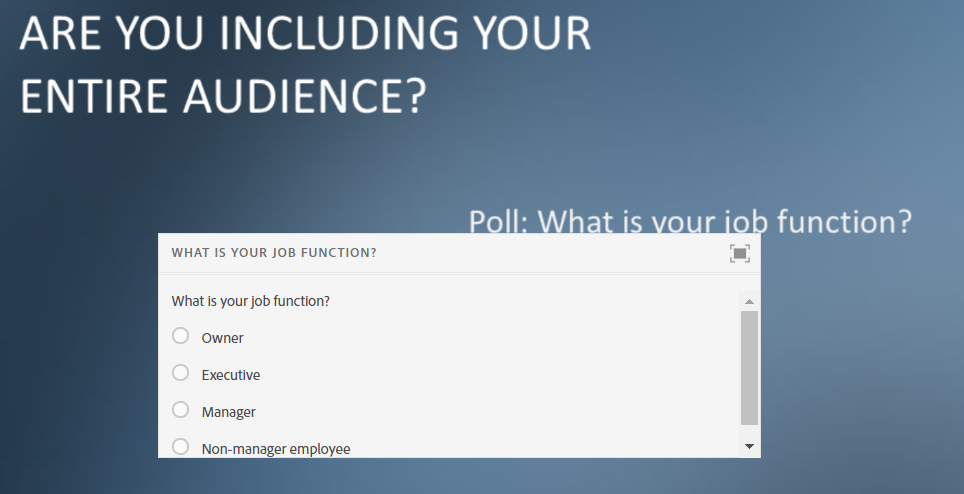
This is better, but still possibly incomplete.
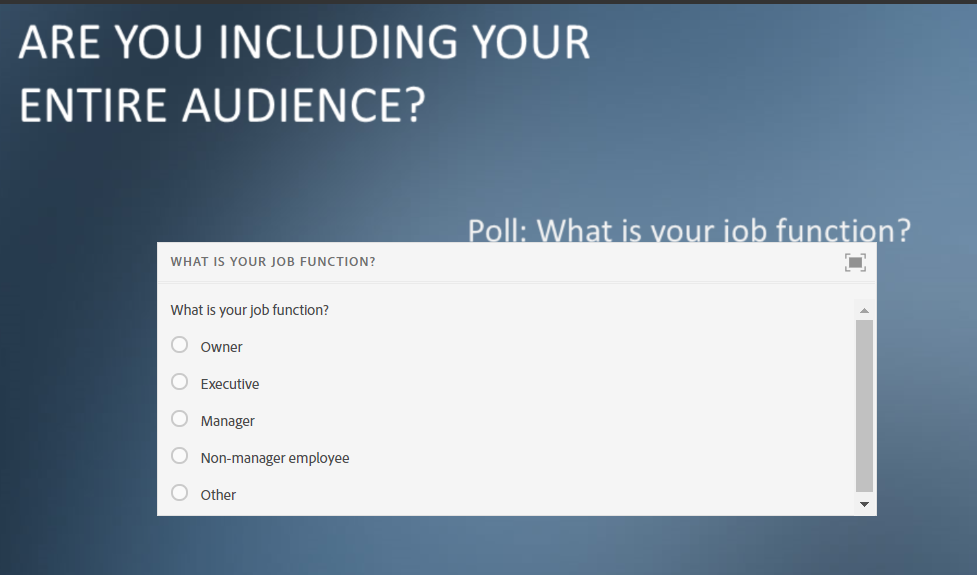
Here, we have used an easy yet effective way to include everyone who is watching.
Gamification can be an effective way to make more of your audience feel included with little effort, as long as the game does not distract the audience from the actual message itself.
Gamifying a concept, question, or lesson does not necessarily mean creating a digital game, but could be as simple as framing a few questions as a quiz. Even a question such as, “What topic do you think will be covered next?” can bring a barrage of answers from the audience – instant gamification.
Even if only a fraction of the attendees participate the first time, it will encourage the others to interact more, going forward.
3) Ways to improve pre-and post-webinar communications:
Pre-webinar:
Pre-webinar communication plays a major role in creating enough buzz and conversation to ensure that the right people find ways to access it.
Asking registrants for suggestions on what topics should be covered in the webinar is an excellent way to engage them and ensure that registrations convert to attendance. While it is necessary to engage the prospects in pre-webinar conversation, it is even more important to not come across as intrusive.
Post-webinar:
As the number of webinars, recordings, and virtual meetings rises at a meteoric rate, it becomes imperative to follow up by reaching out to the attendees as well the registrants who failed to attend. And this must be done as soon as possible, ideally the same day or latest by the next.
Take any longer, and they are likely to have forgotten that they liked the session or how much they got out of it. They will no longer be harboring the right mindset to give back or take the relationship further.
The really effective presenters have their sales teams ready to reach out to prospective customers armed with answers to their questions. These would most likely be questions about pricing, availability, or usage. This would not only not come across as intrusive, but instead, make your team appear to be highly responsive.
4) How does video help or hurt your webinar:
“Videos are highly overrated”, says Ken. He thinks that the idea that video is mandatory regardless of the circumstances or topics is leading to lower levels of engagement. While there is no doubt that video is an extremely powerful learning and communication tool, it also pays to look into how that is changing with a manifold increase in its use.
As the use of live video increases, it becomes ever more important to try and understand the different factors involved:
Expected production quality
Overcoming screen fatigue
Psychological exhaustion
Available bandwidth
As the number of virtual events rises, it is becoming increasingly evident that people do not complain about a lack of video interface if the content is valuable enough. Presenters need to figure out whether the video is important for each session depending on different factors and then use it appropriately.
5) Why shrinking attention spans are a myth
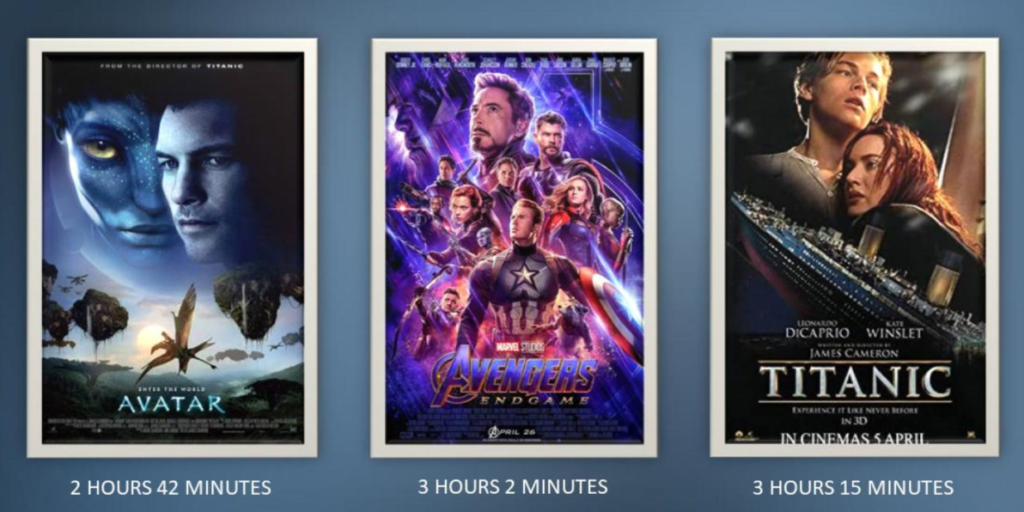
One of the little details I loved about Ken’s session was how he creatively busted the myth that attention spans are shrinking. Given below is the picture and they are some of the highest grossing movies in history. Interestingly, all three movies fall in the category of what one might call lengthy movies, each of them nearly 3 hours long!
Waning attention and lack of interest might be a result of the content that is not interesting and not because of shrinking attention spans. What IS shrinking is the tolerance for unnecessary things. So Ken’s excellent advice to every presenter or trainer is not to try and stuff the session with things you hope will be interesting, but to get completely comfortable with your content and your audience. And to pay attention to everything they tell you.
To sum things up, it is safe to say that while we do not and should not change everything we know about webinars. What it really boils down to is how we talk about our priorities, manage the expectations of the audience, and see where additional attention or investment might be necessary. If you would like a closer look at what audiences expect from a top-notch webinar and discover ways to meet those expectations, check out the recording of Ken Molay’s session.
Adobe Connect is a leading webinar solution designed to be a single platform to plan, deliver, and track highly engaging webinars. Visit https://www.adobe.com/products/adobeconnect/webinars.html for a 30-day free trial or visit https://www.connectusers.com/ for more how-to tips on designing and elevating audience engagement.
